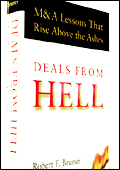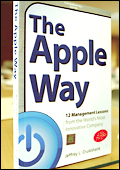 |
DEALS FROM HELL
By Robert F. Bruner
Wiley & Sons
Pp: 420
Price: Rs 1,348 |
We've
been told so by so many and so often that we now tend to take
it as a gospel truth: M&As don't work. Read the popular and
academic literature on the subject, and you'll be told that six-or
even more-out of every 10 M&A deals end up as failures. Reasons
could be anything: The purchaser overpaid, there were little synergies
in the merging businesses, cultural differences were too wide...But,
usually, by the time the shareholders find out, it is too late.
In Deals from Hell, Robert Bruner says it needn't be so. In fact,
Bruner, an M&A expert at the University of Virginia's Darden
School of Business, argues that M&As do pay and can be made
more valuable. How? "You must have a view about the underlying
drivers of M&A profitability to make intelligent guesses,"
answers Bruner.
One of the first things we need to understand,
the Darden professor argues, is that all M&A is local. That
is, one must consider the market dynamics specific to a business.
"An understanding of these neighbourhoods can help...tilt
the odds in favour of an economically successful deal," he
says. Based on his study of "neighbourhood maps", Bruner
lists circumstances under which M&As are likely to fail. Broadly,
the deal will go wrong if you've entered an unrelated business
or the economic benefits from it aren't incremental.
But Bruner doesn't stop at saying what works
and what doesn't. He gets into the why of it as well. To do that,
he considers 2,804 transactions that took place in the US between
1985 and 2000, and based on their performance, categorises them
as best and worst. The differences he finds between the best transactions
and the worst transactions are rather interesting. For instance,
the best transactions start showing material gains within the
first 20 days of the deal announcement; for the worst deals, the
returns are modestly negative for the first 99 days. Thereafter,
things improve rapidly in the case of best deals, while they deteriorate
for the worst ones. There are some other learnings: all-cash deals
seem to do better than stock-swaps; and deals that are big relative
to the size of the buyer tend to perform worse than smaller deals.
Bruner then goes on to look at some real-life
disasters (including the Union Carbide disaster in Bhopal) to
come up with lessons that managers can draw on in combating M&A
disasters. But what the readers will likely find more interesting
are the 10 case studies that typify deals from hell. Bruner's
message to CEOs is simple: Don't do deals for the sake of making
up numbers; do deals only if they add intrinsic value to your
business. A simple message, but often unheeded in the heat of
M&As.
 |
THE APPLE WAY
By Jeffrey L. Cruickshank
Tata McGraw-Hill
Pp: 206
Price: Rs 275 |
Steve
jobs and apple computers have ridden (and are still riding) a
rollercoaster. The company is simply fantastic when it rides the
crest; but has also floundered on the edge of bankruptcy for a
considerable phase of its life. Jeffrey L. Cruickshank's The Apple
Way is part history, recording the twists and turns in the affairs
of the company and the tempestuous and often discordant relationship
between its co-founders-both Steve, one Jobs and the other Wozniak.
It is also part history of the evolution of the PC, and later,
such iconic products as the iMac and the iPod. It tells how Microsoft
licensed the windows and graphic user interface applications from
Apple to create Windows 1.0.
There's also a very interesting chapter on
how Apple creates a cult by building up real or imaginary Bad
Guys, whom it then squares up against. The list of Bad Guys includes
IBM, Microsoft and even its own roster of customers.
But this book is not just about corporate
history. Cruickshank draws 12 important lessons that management
students and aspiring institution builders can learn "from
the world's most innovative company". What are they? Read
the book to find out.
|





